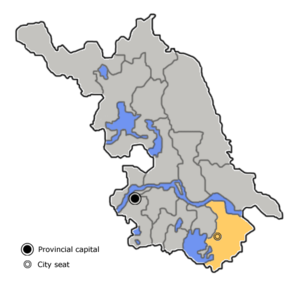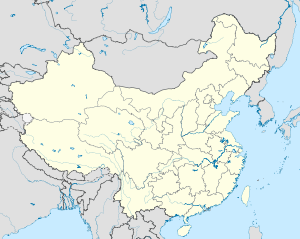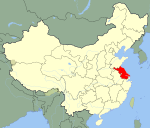- Changshu
-
Changshu
常熟市
Chángshú Shì— County-level city — Location in Jiangsu Location in China Coordinates: 31°18′N 120°36′E / 31.3°N 120.6°E Country China Province Jiangsu Prefecture Suzhou Government – Type County-level city – CPC Changshu Committee Secretary< Wang Xiang Area[1] – Total 1,264 km2 (488 sq mi) Population (2005) – Total 1,047,700 – Density 828.9/km2 (2,146.8/sq mi) Time zone China Standard Time (UTC+8) Postal code 215500 Area code(s) 0512 Website http://www.changshu.gov.cn/ Changshu (Chinese: 常熟; pinyin: Chángshú; Wade-Giles: Ch'ang-shu; lit. "a place of all time harvest")[2] is a county-level city under the jurisdiction of Suzhou, and is located in the south-eastern part of eastern-China’s Jiangsu Province as well as the Yangtze River Delta. Due to the mild climate and terrain there, it has enjoyed a high level of agriculture civilization since ancient times, and is named after this, for in Chinese Chang (常) means “always, often” and Shu (熟) has the meaning of “crop harvest”. Not surprisingly, there is a town nearby called Taicang which means “Greatest Granary”.
Changshu comprises 12 towns and two provincial economy and technology development districts. As a historically and culturally famous city, Changshu is known for its long history, beautiful scenery and prosperity. It is one of the most well developed counties in China: its GDP reached 97.2 billion yuan in 2007, and GDP per capita reached 91,846 yuan (ca. US$12,000), ranking among the top 10 counties within China.
Contents
History
Changshu first became an independent county in 540 AD, but in 581 was made subordinate to Suzhou. It was promoted to seat of a full prefecture in 1295, was rebuilt and fortified in the 14th century, but in 1370 was reduced again to the level of a county. In the 15th and 16th centuries Changshu was several times attacked by Japanese pirates.
Changshu has traditionally been a market town for locally-produced rice, corn, wheat, tea, and mulberry leaves, and since the 13th century has been a major cotton-producing district. Although administratively still a subordinate city to Suzhou, it is a provincial base of foreign trade. Currently a harbour is being developed on the Yangtze River near Changshu to service Suzhou and Wuxi.
Economy
Changsu has experienced economic growth of 15–20 percent for the last 20 years. In 2007, Changshu had a GDP of RMB97.6 billion, an increase of 18 percent from 2006. Of this, only 1.8 percent comes from the primary industry, whereas 59.18 percent is derived from the secondary industry and the tertiary industry makes up the remaining 39 percent.[3]
The city’s major industries include textiles, paper-making, fine chemicals, machinery, steel and forestry products. The city has more than 4,000 textile and apparel companies with combined annual sales of RMB50 billion. The paper-making industry has attracted more the US$15 billion of FDI. By the end of 2007, this industry exceeded 2.4 million tons.[3]
More than 2,000 foreign enterprises have invested in Changshu including big names such as Sharp and Dunlop. Of the contracted investment at least one-third has come from Taiwan – more than 500 Taiwan enterprises have invested more than US$100 million in the city. UPM-Kymmene from Finland has been running a paper mill in the city since 1999 and now has an annual capacity of 200,000 tons of coated and 600,000 tons of uncoated fine paper. Changshu’s import and export rate has also increased in recent years with imports going up by 88.4 percent to US$3.89 billion and exports rising 60.4 percent to US$6.74 billion in 2007.[3]
Development Zones and Ports
- Changshu Port
- Changshu Southeast Development Zone
- Jiangsu New and High Tech Industrial Park
Administrative divisions
Changshu is divided into 12 towns, one forest farm, two provincial development districts and a clothing and fabric market.
12 Towns
- Meili (梅李)
- Bixi (碧溪)
- Xushi (徐市)
- Heshi (何市)
- Dongbang (董浜)
- Renyang (任阳)
- Zhitang (支塘)
- Baimao (白茆)
- Guli (古里)
- Tangshi (唐市)
- Shajiabang (沙家浜)
- Yushanzhen (虞山)
- Haiyu (海虞)
- Xieqiao (谢桥)
- Dayi (大义)
- Mochen (莫城)
- Xinzhuang (辛庄)
- Wangzhuang (王庄)
- Yetang (冶塘)
- Liantang (练塘)
- Yangyuan (杨园)
- Zhangqiao (张桥)
Infrastructure
The China National Highway 204 Yantai-Nantong-Changshu-Shanghai, Sujiahang Expressway and Suzhou-Jiaxing-Hangzhou all pass through Changshu. A major new road is planned alongside the Yangtze River from Shanghai to Nanjing, which will also pass through Changshu. This is due to open in October 2008, as will the Su Tong Bridge, which will connect Changshu with Nantong. Set to be the world’s longest cable-stayed bridge when it opens in 2008, the total length will be 32.4 kilometers.[4]
Changshu harbor is ranked sixth out of China’s inland river ports and supports both the Shanghai port and the Suzhou Industrial Park. It currently has 12 docks, with another nine being constructed, operating to 212 ports worldwide.[4]
Forest farm
- Yushan Forest Farm (虞山林场)
Clothing and fabric market
- Zhaoshangcheng (招商城)
Education facilities
College and universities
- Changshu Institute of Technology (常熟理工学院)
- Changshu Radio & TV University (常熟广播电视大学)
High schools
- Changshu High School of Jiangsu Province (江苏省常熟中学)
- High School of Changshu City (常熟市中学)
- Changshu Foreign Language School (常熟市外国语学校)
- Meili High School of Changshu City Jiangsu Province (江苏省常熟市梅李中学)
Vocation schools
- Changshu Farm & Side-line Vocation School
- Changshu Industrial Vocation School
Social Welfare Institute
Changshu Social Welfare Institute (No. 39, Bei Men Da Jie, Changshu City)
Tourism
Gardens and parks
- Fangta Tower Park (方塔园)
- Yushan Hill Park (虞山公园)
- Shanghu Lake Park (尚湖公园)
- The Zengs' Garden (曾园)
- The Zhaos' Garden (赵园)
- The Yan Garden (燕园)
Hills
- Yushan Hill (虞山)
- Fushan Hills (福山诸丘)
- Tongguan Hill (铜官山)
- Dianshan Hill (殿山)
- Xishan Hill (西山)
Archaeological sites
- Xingfu Temple (兴福寺)
- Zhongyong's Tomb (仲雍墓)
- Yanzi's Tomb (言子墓)
Transportation
- Railroad: the Yangtse Riverine Railway (planning)
- Highways: the Yangtse Riverine Expressway, the Suzhou-Jiaxing-Hangzhou Expressway
Sister and friend cities
 Whittier, California
Whittier, California Burnaby, British Columbia, Canada
Burnaby, British Columbia, Canada Ayabe, Kyoto, Japan
Ayabe, Kyoto, Japan Satsumasendai, Kagoshima, Japan
Satsumasendai, Kagoshima, Japan Townsville, Australia
Townsville, Australia
Famous people
- Weng Tonghe (1830–1904), Confucian scholar and imperial tutor of two emperors during the Qing dynasty
At least four famous painters came from Changshu:
- Huang Gongwang (1269–1354), one of the Four Masters of the Yüan dynasty
- Wang Hui (1632–1717), one of the "Four Wangs" representing the orthodox school of painting during the Ming and early Qing dynasties
- Wu Li (1632–1718), one of the orthodox school of "literati painting" (wenrenhua) in the early Qing dynasty
- Jiang Tingxi (1669–1732), official painter and grand secretary to the Imperial Court.
- Wang Ganchang (1907–1999), an outstanding nuclear physical scientist
References
- ^ "Table showing land area and population". Suzhou People's Government. 2003. http://suzhou.sz2500.com/english/Survey/pic/d.jpg. Retrieved 2007-09-07.
- ^ Spelling variants in older written sources might be Chansu (e.g. Encyclopaedia Britannica, 1911) or Chanzu (e.g. The New Larned History for Ready Reference, 1922).
- ^ a b c China Briefing Business Guide: Changshu Economy
- ^ a b China Briefing Business Guide: Changshu Infrastructure
External links
- http://www.changshu.gov.cn/ - official Changshu City website
- Changshu City English guide (Jiangsu Network)
- Wikitravel's Changshu page - Travel information
Coordinates: 31°39′N 120°44′E / 31.65°N 120.733°E
Jiangsu topics General Geography Cities • Grand Canal of China • Yellow Sea • East China Sea • Xishan Island •
Yangtze River • Lake Tai • Hongze Lake • Yangcheng Lake • Huai RiverEducation Culture Visitor attractions Purple Mountain • Sun Yat-sen Mausoleum • Ming Xiaoling Mausoleum • Jiming Temple • Nanjing Yangtze River Bridge • Hanshan Temple • Huqiu Tower • Grand Buddha at Ling Shan • Chaotian Palace • Qixia Temple • Tianning Temple PagodaJiangsu Province county-level divisions Nanjing: Xuanwu District · Baixia District · Qinhuai District · Jianye District · Gulou District · Xiaguan District · Pukou District · Luhe District · Qixia District · Yuhuatai District · Jiangning District · Lishui County · Gaochun County
Wuxi: Chong'an District · Nanchang District · Beitang District · Binhu District · Huishan District · Xishan District · Wuxi New District · Jiangyin City · Yixing City
Xuzhou: Yunlong District · Gulou District · Jiuli District · Jiawang District · Tongshan District · Quanshan District · Pizhou City · Xinyi City · Suining County · Pei County · Feng County
Changzhou: Zhonglou District · Tianning District · Qishuyan District · Xinbei District · Wujin District · Jintan City · Liyang City
Suzhou: Jinchang District · Canglang District · Pingjiang District · Huqiu District · Wuzhong District · Xiangcheng District · Wujiang City · Kunshan City · Taicang City · Changshu City · Zhangjiagang City
Nantong: Chongchuan District · Gangzha District · Haimen City · Qidong City · Tongzhou District · Rugao City · Rudong County · Hai'an County
Lianyungang: Xinpu District · Lianyun District · Haizhou District · Ganyu County · Guanyun County · Donghai County · Guannan County
Huai'an: Qinghe District · Qingpu District · Chuzhou District · Huaiyin District · Jinhu County · Xuyi County · Hongze County · Lianshui County
Yancheng: Tinghu District · Yandu District · Dongtai City · Dafeng City · Sheyang County · Funing County · Binhai County · Xiangshui County · Jianhu County
Yangzhou: Guangling District · Weiyang District · Hanjiang District · Yizheng City · Jiangdu City · Gaoyou City · Baoying County
Zhenjiang: Jingkou District · Runzhou District · Dantu District · Yangzhong City · Danyang City · Jurong City
Taizhou: Hailing District · Gaogang District · Jingjiang City · Taixing City · Jiangyan City · Xinghua City
Suqian: Sucheng District · Suyu District · Shuyang County · Siyang County · Sihong CountyCategories:- Cities in Jiangsu
- Suzhou
- Alliance for Healthy Cities
Wikimedia Foundation. 2010.



